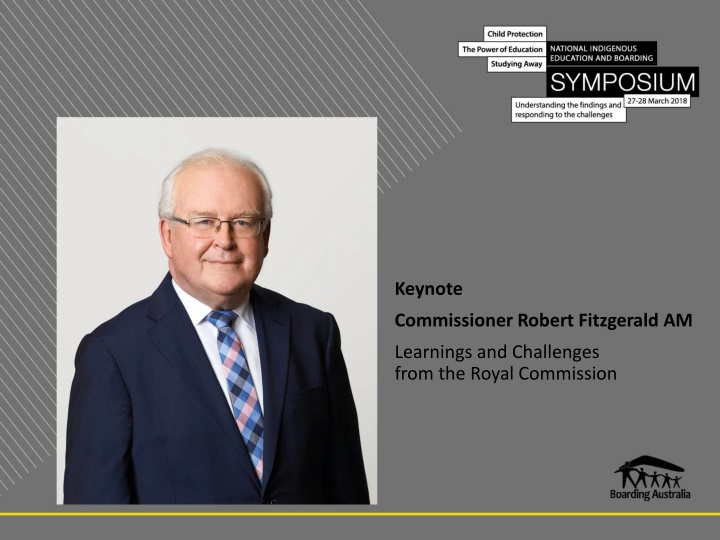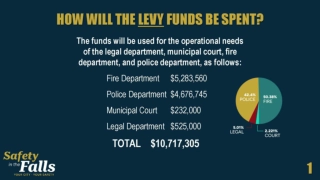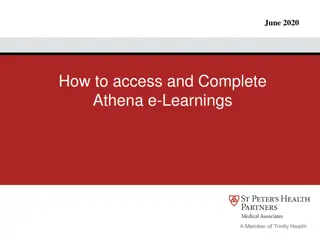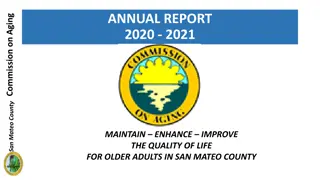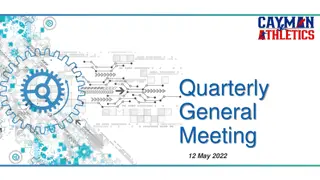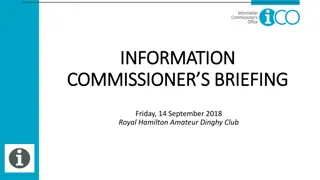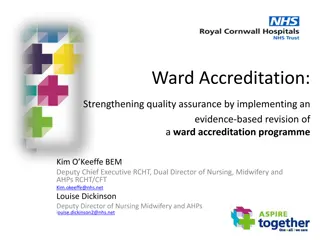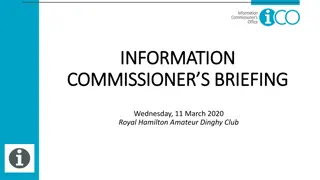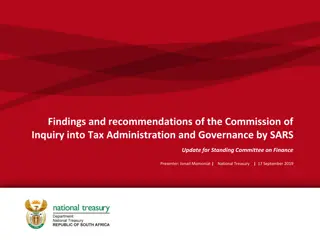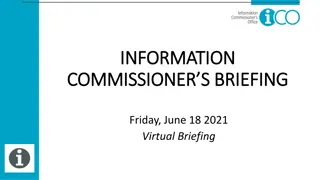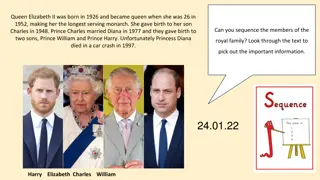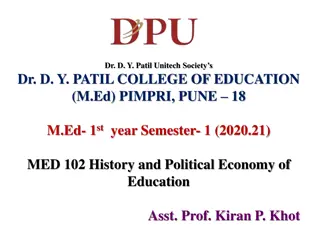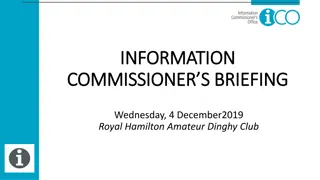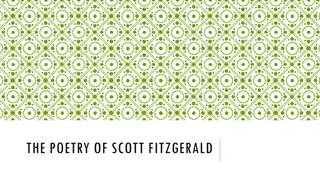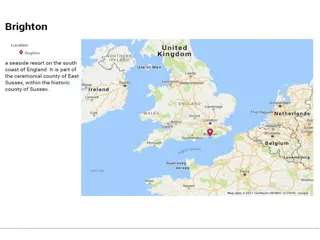Learnings and Challenges from the Royal Commission by Commissioner Robert Fitzgerald AM
Commissioner Robert Fitzgerald AM shares insights from the Royal Commission on addressing child abuse in various institutional contexts, highlighting the importance of listening to survivors, reflecting on past failures, and empowering victims to create safer environments for children. The Commission's focus on historical residential institutions, out-of-home care, schools, sports groups, and religious institutions underscores the need for a cultural shift to protect vulnerable individuals. Private session data reveals the prevalence and duration of abuse, emphasizing the urgency of effective institutional management to safeguard children.
Download Presentation

Please find below an Image/Link to download the presentation.
The content on the website is provided AS IS for your information and personal use only. It may not be sold, licensed, or shared on other websites without obtaining consent from the author.If you encounter any issues during the download, it is possible that the publisher has removed the file from their server.
You are allowed to download the files provided on this website for personal or commercial use, subject to the condition that they are used lawfully. All files are the property of their respective owners.
The content on the website is provided AS IS for your information and personal use only. It may not be sold, licensed, or shared on other websites without obtaining consent from the author.
E N D
Presentation Transcript
Keynote Commissioner Robert Fitzgerald AM Learnings and Challenges from the Royal Commission
Learnings and Challenges from the Royal Commission Educational and Boarding Environments for Indigenous Children
OUR TASK To bear witness To propose just responses To create safe institutions Failure, Resilience and Opportunity
Your Task To listen deeply to what has been disclosed and discovered To reflect and learn from past failures To listen to and empower victims and survivors To assess risks and protective factors To create new culture that promote the best interests of children and to shape and sustain safer organisations for children
Focus on institutional contexts and responses To fully examine institutional responses to child sexual abuse and how we can better protect children, the Royal Commission chose a range of institution types for in-depth examination: Historical residential institutions Contemporary out-of-home care Schools Sport, recreation, arts, culture, community and hobby groups Contemporary detention environments Religious institutions
What we heard in private sessions Survivor as at 1st December 2017 63.6% were male 14.9% identified as Aboriginal and/or Torres Strait Islander 4.2% had disability at the time of the abuse the average age at the time of their private session was 52 years the average age at the time of first abuse was 10.4 years.
What we heard in private sessions Duration of abuse, as at 31st May 2017 In private sessions, 74.3% of survivors talked about the duration of the abuse: Of these: 2.2 years on average 14.4 % of female victims and 8.9 % of male victims experienced abuse for between 6 and 10 years 3.9% of female victims and 1.0% of male victims said the abuse went on for more than 10 years.
Institution management From private sessions, as at 1st December 2017 Of the 7,981survivors of abuse we heard from in private sessions: 58.1% of survivors said the abuse took place in an institution managed by a religious organisation 32.5% in a government-run institution 10.5% in a non-government, non-religious institution. We heard about 3,489 institutions where we were told that child sexual abuse had occurred.
Institution type Number and proportion of survivors by institution type, from private sessions Institution type Out-of-home care Out-of-home care: pre-1990 Out-of-home care: 1990 onwards Unknown era Schools Religious activities Youth detention Recreation, sports and clubs Health and allied Armed forces Supported accommodation Family and youth support services Childcare Youth employment Other Unknown Number 3,277 Proportion (%) 41.1 2,809 298 205 35.2 3.7 2.6 2,521 1,162 639 482 221 105 84 66 41 23 295 96 31.6 14.6 8.0 6.0 2.8 1.3 1.1 0.8 0.5 0.3 3.7 1.2
Role of perpetrators Of survivors who told us about the role of the perpetrator in private sessions, as at 31st May 2017: 32.2% told us they were abused by a person in religious ministry 30.1% told us they were abused by a teacher 13.7% said they were abused by a residential care worker Some survivors also told us they were abused by foster carers, dormitory masters and housemasters, custodial staff, medical practitioners, volunteers, youth group leaders, sporting coaches, and other roles.
Common features of perpetrator roles From private sessions Survivors identified features of the institutional roles the perpetrators were in, including: unsupervised, one-to-one access to child intimate care, greater level of physical contact ability to influence or control aspects of the child s life e.g. academic grades spiritual or moral authority over child prestige, afforded greater trust opportunities to become close with child/family specialist expertise such as medical responsibility for younger children
Common institutional risks Organisational leadership and culture shape assumptions, values, beliefs and norms. These influence how to behave when interacting with children and what is considered appropriate. Risk factors include: prioritising the reputation of the institution over the safety and wellbeing of children failing to listen to and respect children understating the seriousness of allegations and complaints hierarchies that create deferential obedience rather than accountability.
Common situational risks Situationalrisks of abuse arise from: unsupervised, one-to-one access to a child opportunities to form relationships that involve physical contact and/or emotional closeness. These risks are normal features of many institutional settings boarding and day schools, out-of-home care settings, individual tuition, youth camps and sporting activities. Most can be reduced through implementing Child Safe policies and procedures.
Common barriers to disclosure Some of the barriers to disclosing sexual abuse were common in all institutional contexts: shame and embarrassment fear of not being believed, being discredited or even blamed for the abuse threats of violence fear of reprisals institutional codes of silence or cultures of secrecy.
Institutional barriers to disclosure Governance and leadership that: prioritises reputation, prestige or loyalty to the institution above children s safety features strong personal relationships between adults within institutions, or conflicts of interest for individuals in institutions. allows widespread sexual abuse, physical punishment, violence and retribution. Common factors across institutions include: not following policies and procedures, or not having any in place inadequate avenues for disclosure and poor institutional responses to sexual abuse or related behaviours, such as bullying inadequate recordkeeping and information sharing.
Supporting disclosure For children To support disclosure, children need: access to safe adults opportunities to raise and discuss concerns information about sexual abuse and access to sexual abuse prevention programs to learn how to provide peer support appropriate tools to communicate abuse.
Some impacts of child sexual abuse For many children, sexual abuse has significant lifelong impacts. Some of the impacts reported to us by survivors of abuse in the particular institutions we focused on were: complex trauma and cumulative harm betrayal and loss of trust unhappiness at school, learning difficulties and decline in academic performance loss of sport or recreational activity and community that was once enjoyed loss of religious faith and/or spiritual confusion ostracism by religious families and/or communities.
Historical residential institutions (pre-1990) Volume 11
Historical residential institutions (pre-1990) More than one-third of all survivors who attended private sessions told us the abuse took place in an historical residential institution. Institutions included missions, orphanages, children s homes, reformatories, reception centres, family group homes, training centres, mental health and disability institutions and hostels. Among the survivorswere high numbers of Forgotten Australians , Stolen Generations , former child migrants, children with disability. Nine case studies examined historical residential institutions.
Social context influenced risks Prevailing social attitudes influenced the way children were treated: >500,000 children experienced institutional care in the 20th century until the late 1960s, forcible removal of children from their families was common Aboriginal and Torres Strait Islander children were systematically removed under separate, discriminatory legislation institutions closed to outsiders, lacked proper oversight little regard for emotional and physical wellbeing of children younger children placed with older children, welfare children placed with children from the justice system, and children with disability or mental health concerns were often placed in adult institutions.
Institutional culture, operations and environment risks to children Many institutions operated as total or closed institutions: children were inmates and their lives completely controlled Cultures directly or indirectly endorsed harmful behaviours and prevented disclosure. Children were punished, strip searched, and sexually abused under the guise of medical procedures Perpetrators held positions of power and children lacked access to potentially protective adults Isolated physical locations, inadequate staff supervision and limited oversight of institutions increased risk.
Experiences in historical institutions Survivors who spent all or part of their childhoods in historical residential institutions described being extremely vulnerable to abuse because they were: isolated from protective adults, family or others perceived as inferior to adults viewed as inferior to other children frightenedof disappearing , as the perpetrator had power and authority over their lives dependent on the institution for personal and other care.
Contemporary out-of-home care Volume 12
Out-of-home care in Australia today State and territory out-of-home care systems accommodate children who are unable to live safely with their families. children usually placed in care following intervention by child protection departments and courts 46,448 children in out-of-home care (30 June 2016)* most children placed in home-based settings kinship/ relative care and foster care fewer in residential care, but still 5% of total *Productivity Commission, Report on government services 2017
Vulnerability of children in care Combination of more risk factors and fewer protective factors heighten the risk of sexual abuse for some children. Key factors that increase the vulnerability of children in care include: the impact of previous maltreatment loss of connection to family and culture multiple placements and parade of strangers limited knowledge/education about sex, sexuality and respectful relationships higher risks of sexual exploitation
Situational risks in out-of-home care Unsupervised, one-to-one access to a child Providing intimate care to a child and/or an expectation of a certain level of physical contact Potential for perpetrators to exploit close relationship with children in their care o the ability to influence or controlaspects of a child s life o authority over a child, especially in domestic settings
Systemic risks in out-of-home care Insufficient screening, authorisation and training of carers and staff Inadequate monitoring and support of placements Acute risks in residential care Over-representation of some groups heighten their exposure to risks eg. 36% of all children in care are Aboriginal or Torres Strait Islander* Failure to assist care-leavers to disclose abuse or access post-care supports *Productivity Commission, Report on government services 2017
Child sexual abuse in schools Volume 13
Australian schools The way schools manage risks of child sexual abuse affects all children. In 2016, 3.8 million children enrolled in 9,400 primary and secondary schools.* 70.5% of schools were government schools, attended by 65.4% of students 29.5% of schools were non-government, attended by 34.6% of students. Of the non-government schools: 62.5% are Catholic 37.5 are independent. *ABS, Schools, Australia, 2016
Wide range of schools examined In private sessions, almost one-third of all survivors told us they were sexually abused in a school setting as a child. 71.8% of those said they were abused in religious schools. Schools were the subject of 13 case studies including government and independent schools, and denominational schools from Catholic, Anglican, Pentecostal and Jewish faiths. One case study looked at the way seven schools responded to children with harmful sexual behaviours. One looked at a school for children with disability. Indigenous QLD Boarding School examined
Common risks in schools Features of the school environment can influence schools ability to keep children safe. Such risks are often evident in schools where: leadership, governance and culture prioritises protecting the school s reputation and financial interests rather than child safety poor complaints and investigation processes deter leaders and staff from taking effective action, including alerting external authorities inadequate recordkeeping and informationsharing perpetuate risks to other children children s participation and empowerment is discouraged engagement with families and communities is limited Insufficient attention is paid to equity and diversity needs.
Boarding Schools Common Themes Vulnerability of children Bullying Culture Complainants further abused or intimidated by staff and students Staff attitudes - tough love, boys will be boys, toughen up, don t dob Lack of protective trusted adults Inadequate staff numbers, training, supervision Older student control of dormitories and younger children Lack of students support following abuse trauma, throughout investigations and post investigations Hostels greater risks
Indigenous students Common Themes Bullying and racial abuse Lack of connectedness to cultural supports Confusion as to what is abuse and how to express concerns Lack of trust in authorities eg police, child protection Lack of parental connectedness to school or hostel Early exposure to problematic child sexual behaviours Lack of culturally appropriate ,trauma informed supports and services. Need for greater staff scrutiny in selection, trauma informed training , abuse education and supervision especially residential workers
Common institutional responses It has been common for institutions to respond to allegations or disclosures of child sexual abuse in the following ways: dismiss or deny allegations punish victims minimise the abuse fail to report to police provide perpetrators with continued access to children and employment adopt in-house responses guided by internal policies or, in religious institutions, religious laws and principles.
Making institutions child safe Not only acting for children, but acting in children s best interest From boardroom to basement.
Foundations for Safer Institutions Changes to civil liability laws Changes to criminal offences and procedures Reportable Conduct Regimes Child Safe Communities Child Safe Standards Improved information Sharing and Record Keeping Better therapeutic supports and services
Making institutions child safe Recommendations for all institutions Our recommendations for all institutions include: implementing Child Safe Standards improving regulation and oversight improving the way complaints and disclosures about child sexual abuse are handled providing workers with skills and knowledge to keep children safe ensuring the safety and wellbeing of children.
Practical Measures Community of Knowledge students, parents, staff open conversation Central contact point for reporting, complaint handling. More than audits of policy- surveys and focus groups Building protective factors in children and recognising resilience anti bullying policies and culture Adequate resourcing of wellbeing and support staff Proper record keeping Information exchange
Specific Recommendations Fit for Purpose For all institutions that provide care or services to children For schools and boarding hostels For religious institutions that are involved in provisions of services or care to children whether worship, pastoral education or other community services.
Making institutions child safe Recommendations specific to schools Some recommendations aim to address specific factors relating to the structure, governance or culture of that institution including schools and hostels. incorporate Child Safe Standards into regulation of schools and boarding hostels. strengthen teacher registration requirements, training and supports improve complaints handling improve practices for dealing with problematic child sexual behaviours Not just educating or housing children, but acting in their best interest
A child safe organisation Beyond policies and procedures A culture that is child focussed A deep understanding by all staff and boards A community of knowledge Looking through the eyes of the child, parent, carer, staff member, the community - not just audits.
Learnings and Challenges from the Royal Commission Educational and Boarding Environments for Indigenous Children
